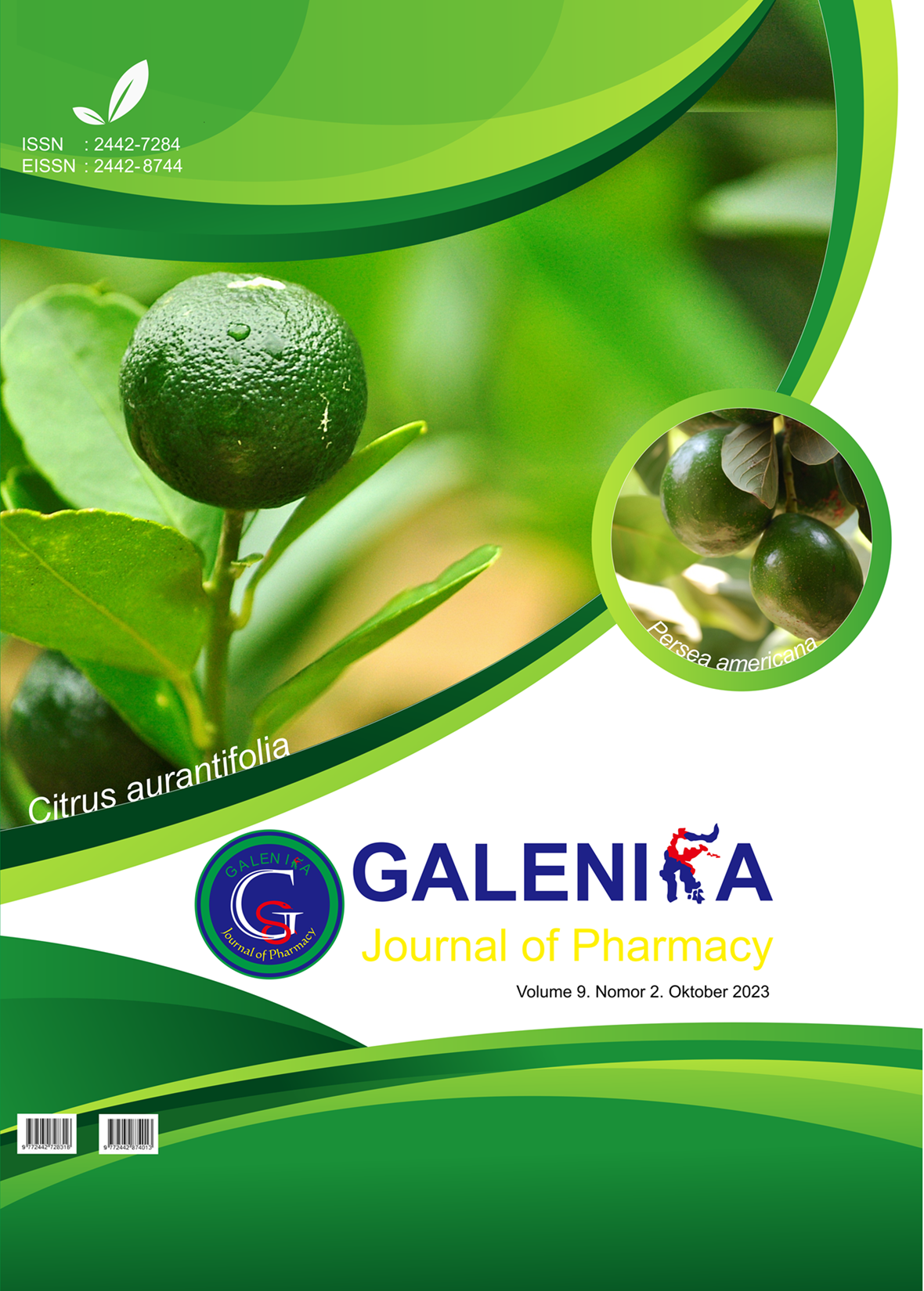Main Article Content
Abstract
Background: Standardizing herbal medicines is crucial for assessing their quality and effectiveness. Objectives: This study aims to determine non-specific and specific standardization parameters for medicinal plants. Non-specific parameters include drying shrinkage, water content, total ash content, acid insoluble ash content, total bacteria, total mold, and metal limits (Pb, Hg, and Cd). Specific parameters involve organoleptic examination, identification of chemical content in extracts, dissolved compounds in specific solvents, total flavonoid content, and qualitative testing of anthocyanin content in the extract. Materials and Methods: An experimental laboratory approach was employed to extract Dioscorea alata L using 96% ethanol, which was later concentrated through a rotary evaporator to obtain a viscous extract. Specific and non-specific parameters were determined using standardized techniques. Results: The extract yielded 3.32% of the initial substance. Drying shrinkage was 19.7769±1.2682%, and specific gravity was 0.6192±0.1476 gram/ml for 5% m/v and 0.5101±3.9591 gram/ml for 10% m/v. Ash content was 0.6793%, with acid insoluble ash content at 0.1895%. Heavy metal contamination for Hg was 0.47 ppm, but undetected for Pb & Cd). The total plate number was 27 x 103 colonies/g, and negative Escherichia coli contamination. The mold count was 39 x 101 colonies/g. Additional specific parameters included the organoleptic properties of the viscous extract (purple color, characteristic odor, and sweet taste), water-soluble compound content (15.63%), ethanol-soluble compound content (14.73%), and a flavonoid content of 76.669 mg EQ/100 mg. Conclusions: The ethanol extract of Dioscorea alata complies with the standard requirements established by the Food and Drug Supervisory Agency. It presents as a viscous extract with a distinct odor, purple-black color, and sweet taste. The extract contains alkaloids, flavonoids, saponins, tannins, steroids, and phenolic compounds, with a total flavonoid content of 76.669 mg. Furthermore, it tested positive for anthocyanins.
Keywords
Article Details

This work is licensed under a Creative Commons Attribution-NonCommercial-ShareAlike 4.0 International License.
References
- Adrianta, KA (2016). Identification of Anthocyanin Compounds and Secondary Metabolites from Ethanol Extract of Black Glutinous Rice (Oryza sativa L.) in Its Utilization as an Alternative Treatment of Dengue Hemorrhagic Fever. Medicamento Scientific Journal, 2 (1), 17-22.
- Ahmad, AR, Sakinah, Wisdawati, & Asrifa, WO (2014). Study of antioxidant activity and determination of phenol and flavonoid content of pepino's leaf extract (Solanum muricatum aiton). International Journal of PharmTech Research, 6(2), 600–606.
- Anonymous, 1979, Indonesian Pharmacopoeia, Edition III, Ministry of Health of the Republic of Indonesia, Jakarta
- Azizah, B. and Salamah, N., 2013. Standardization of Non-Specific Parameters and Comparison of Curcumin Levels in Ethanol Extract and Turmeric Rhizome Purified Extract. Pharmaciana, 3(1)
- Calixto JB and Barz J., 2000. Efficacy, safety, quality control, marketing and regulatory guidelines for herbal medicines (phytotherapeutic agents), Med Biol Res ; 33:179-189.
- Chanchal DK, Niranjan P, Alok S, Kulshreshtha S, Dongray A and Dwivedi S., 2016. A Brief Review on Medicinal Plant and Screening Method of Antilithiatic Avtivity. Int J Pharmacognosy ; 3(1): 1-9:.
- Chang C. Yang M, Wen Hand Chern J. 2002. Estimation of Total Flavonoid Content in Propolis by Two Complementary Colorimetric Methods, J. Food Drug Anal
- Ministry of Health RI, 2000. General Standard Parameters of Medicinal Plant Extracts. Directorate General of Drug and Food Control, Jakarta
- Dixit VK and Yadav NP., 2008. Recent approaches in herbal drug standardization. Integral Biol ; 2(3):195-203.
- Harborne, JB 1984. Phytochemical Methods: A Guide to Modern Techniques of Plant Analysis (2nd edn). London: Chapman and Hall.
- Harborne, JB 1987. Phytochemical Methods Guiding Modern Ways of Analyzing Plants. Bandung: ITB Publisher.
- Jawetz, MD, Melnick, JL, Edward, AA, Brooks, GF, Butel, JS, Omston, LN, 2010, Medical Microbiology. 25th edition, MeGraw Hill, San Francisco, pp 72, 74
- Kurniasari, I. (2006). Rapid Method of Determination of Meniran (Phyllantus niruri L.) Total Flavonoids Based on Infrared Spectrophotometry and Chemometrics. Bogor : IPB
- Lu, FC 2006. Basic Toxicology: principles, target organs, and risk assessment. Translator; Edi Nugroho; Zunilda S. Bustami's companion, Iwan Darmansyah. UI-Press. Jakarta.
- Marjoni, MH (2016). Phytochemical Fundamentals. Jakarta: Trans Info Media
- Nida, Melly and Syarifah Rohaya. 2013. Anthocyanin Content and Antioxidant Activity of Fresh Purple Sweet Potato and Their Processed Products. Banda Aceh: Syiah Kuala University.
- Moody, 2005, Breastfeeding: Easy, Practical and Convenient Way, Arcan, Jakarta, pp 6
- Perko, B. 2011. Effect of prolonged storage and microbiological quality of raw milk. Microbiological quality of raw mil. Mjekar Stvo. 61(2):114-124
- Sundari, T. (2010). Introduction of Superior Varieties and Cassava Cultivation Techniques. Malang (ID): Research Institute for Legumes and Tubers.
- Saifudin, A., Rahayu, & Teruna., 2011., Standardization of Natural Medicines, Graha Ilmu : Yogyakarta.
- Septyaningsih, D. (2010). Isolation and identification of the main components Red fruit seed extract (Pandanus conoideus lamk.).
- Ukieyana, E., 2012, Antioxidant Activity, Total Phenolic and Flavonoid Levels of Plants (Peperomia pellucid L. Kunth). Faculty of Agricultural Technology, Bogor Agricultural University. Bogor
- Voigt, R., 1995, Pharmaceutical Technology Textbook, 5th Edition, Gajah Mada University Press, Yogyakarta.
- WHO, Global Atlas of Traditional, 2005. Complementary And Alternative Medicines. World Health Organization. Geneva, Switzerland.
- Yusuf, La Ode Muhammad. 2016. Morphological Characters and Chemical Content of Dioscorea L. Bulbs on Wangi-Wangi Island, Wakayobi Regency, Southeast Sulawesi. Kendari: Department of Biology, Haluoleo University.

